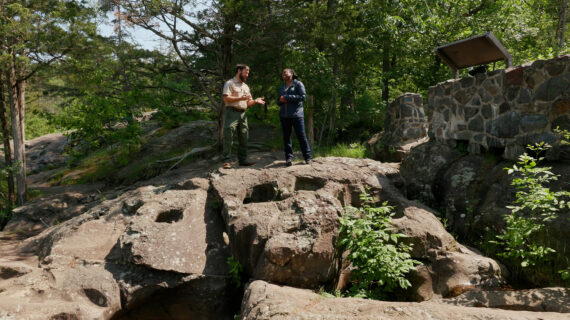Frederica Freyberg:
The state’s largest business lobby applauds proposed legislation to eliminate enhanced unemployment benefits of an extra $300 per week and the move that reinstates the work search requirement to receive benefits. That requirement takes effect Sunday. The Wisconsin Manufacturers and Commerce says there is a crisis level workforce shortage and pandemic-related policies create a disincentive to work. Where have all the workers gone and what will bring them back? For some answers to these questions and more, we turn to the Wisconsin Department of Workforce Development Chief Economist Dennis Winters. Thanks very much for being here.
Dennis Winters:
Good. Glad to be here.
Frederica Freyberg:
So in your estimation are enhanced unemployment benefits keeping people at home and out of the workforce?
Dennis Winters:
Well, I don’t think that’s the preliminary reason or the primary reason that we are seeing, you know, a shortage of workers through the state. It may have some effect now that the economy is opening. There has been some studies that have shown there is some disincentive depending on the gap between what they are getting in benefits and what they normally make in their salaries. But that’s not widespread at this point. But as we transmission to a more open economy, yeah, it might be a little disincentive now that there are jobs to go back to, sure.
Frederica Freyberg:
You’re saying it’s not the primary reason, though. What is?
Dennis Winters:
Well, the primary reason as we talked about for some time is there is just a shortage of bodies, a shortage of citizens in the state of Wisconsin to fill all these jobs. We had the same situation that we’re hearing about before the great recession back in ’07. That let some of the pressure out of the pot, right? As soon as we turned around from there, businesses were complaining that they couldn’t find enough workers then. This is the same situation. The only thing that’s happened is the baby boomers have gotten 10, 11 years older through the great recession and are retiring out of the workforce.
Frederica Freyberg:
And so what needs to be done? I know that employers — you see it kind of all over the place. They’re kind of boosting their lower level wages some. What needs to be done? Is it about boosting wages and other things that they can do to attract employees?
Dennis Winters:
Well, part of it will be boosting wages for any particular firm. But if overall you just have a shortage of workers, at some point higher wages aren’t going to matter. You’re just going to run out of supply is kind of what we’re doing. So there have to be other incentives to get more bodies into the workforce and they may have to come from other places.
Frederica Freyberg:
Like?
Dennis Winters:
Well, they can come from neighboring states if in fact they let us take all their workers, so there will be competition among other states to do the same thing. Another solution is from other countries and immigration. The U.S. is still a place that people want to come to, so that’s one solution for the supply.
Frederica Freyberg:
So how does a worker shortage in this way affect Wisconsin’s economy?
Dennis Winters:
Well, as you have heard, it affects in the sense we can’t — a lot of companies cannot produce the orders that they have coming into their shops. So that dampens how much goods and services are being provided and slows economic growth. The thing we have — we have to raise productivity, right, of the workers and the technology and match them to be able to keep growing the economy.
Frederica Freyberg:
And so it sounds like an intractable problem, right, because it’s just frankly a shortage of, as you said, bodies. But is there — are there some solutions that jump out at you at this time when people are calling it a crisis?
Dennis Winters:
Well, yeah. Some solutions, again, are immigration. For example, in the hospitality industry, right, the visas that they use to bring in summer help, particularly around places like the Dells in Wisconsin. There’s limits there about how many people they are allowed to bring in. So that’s one solution. You could open some of that up. Another solution is immigration as a whole and bringing in workers from all over the world. The other resource I see that’s untapped that we need to tap into is what I call the chronically unemployed, those that have a number of barriers. Either it’s transportation, it’s day care, it’s skill levels. There’s a segment of that that we have to tap into in this state. And the state’s doing a lot in training programs to try to get those people up to speed. But if your workforce is flattening out on top, you’ve got to go to the supply that’s untapped within the state.
Frederica Freyberg:
All right. We leave it there. Lots more to talk about on this, though. Dennis Winters, thank you very much.
Dennis Winters:
You’re welcome. Thank you.
Search Episodes
Related Stories from PBS Wisconsin's Blog

Donate to sign up. Activate and sign in to Passport. It's that easy to help PBS Wisconsin serve your community through media that educates, inspires, and entertains.
Make your membership gift today
Only for new users: Activate Passport using your code or email address
Already a member?
Look up my account
Need some help? Go to FAQ or visit PBS Passport Help
Need help accessing PBS Wisconsin anywhere?

Online Access | Platform & Device Access | Cable or Satellite Access | Over-The-Air Access
Visit Access Guide
Need help accessing PBS Wisconsin anywhere?

Visit Our
Live TV Access Guide
Online AccessPlatform & Device Access
Cable or Satellite Access
Over-The-Air Access
Visit Access Guide
 Passport
Passport


















Follow Us